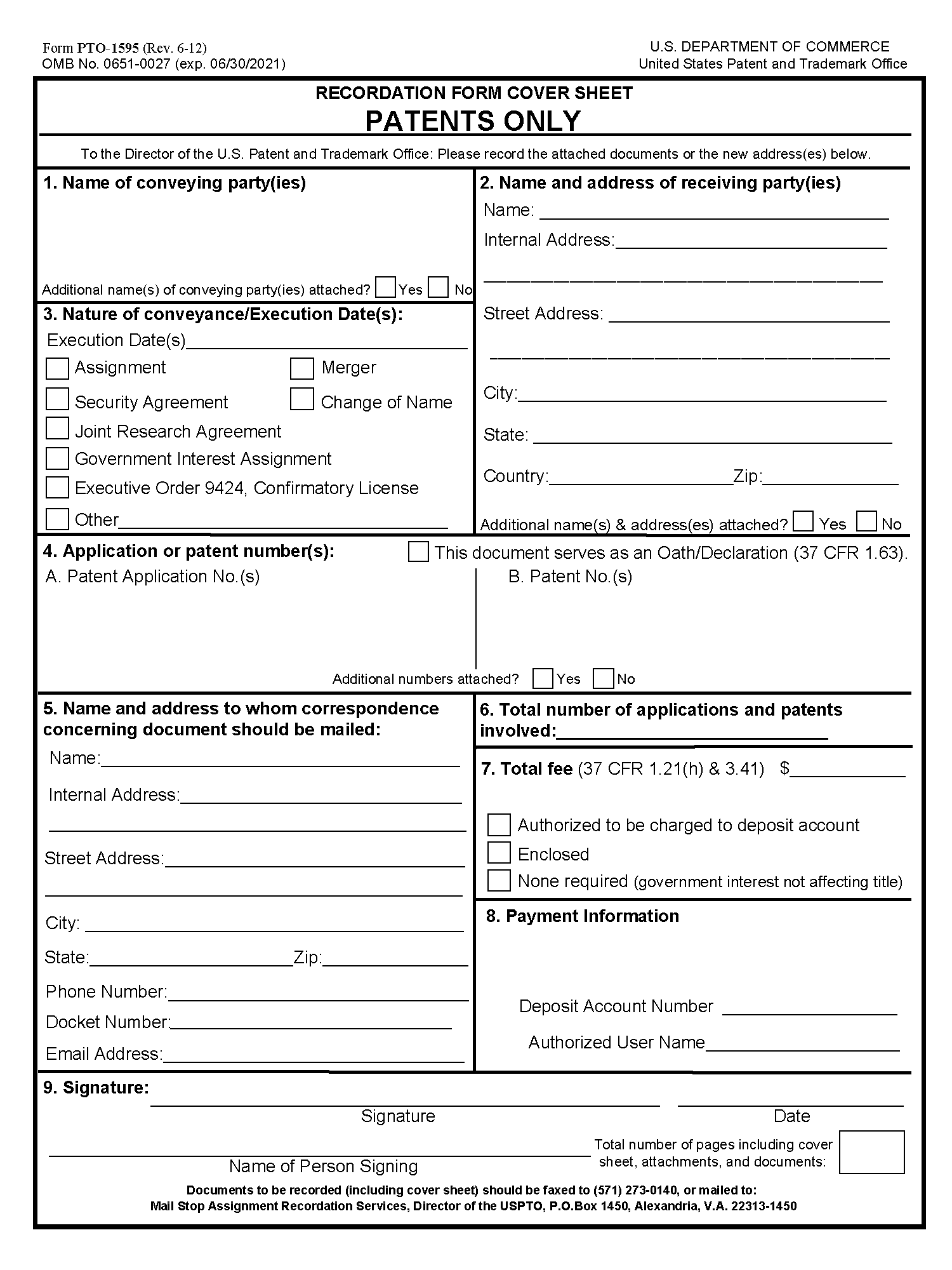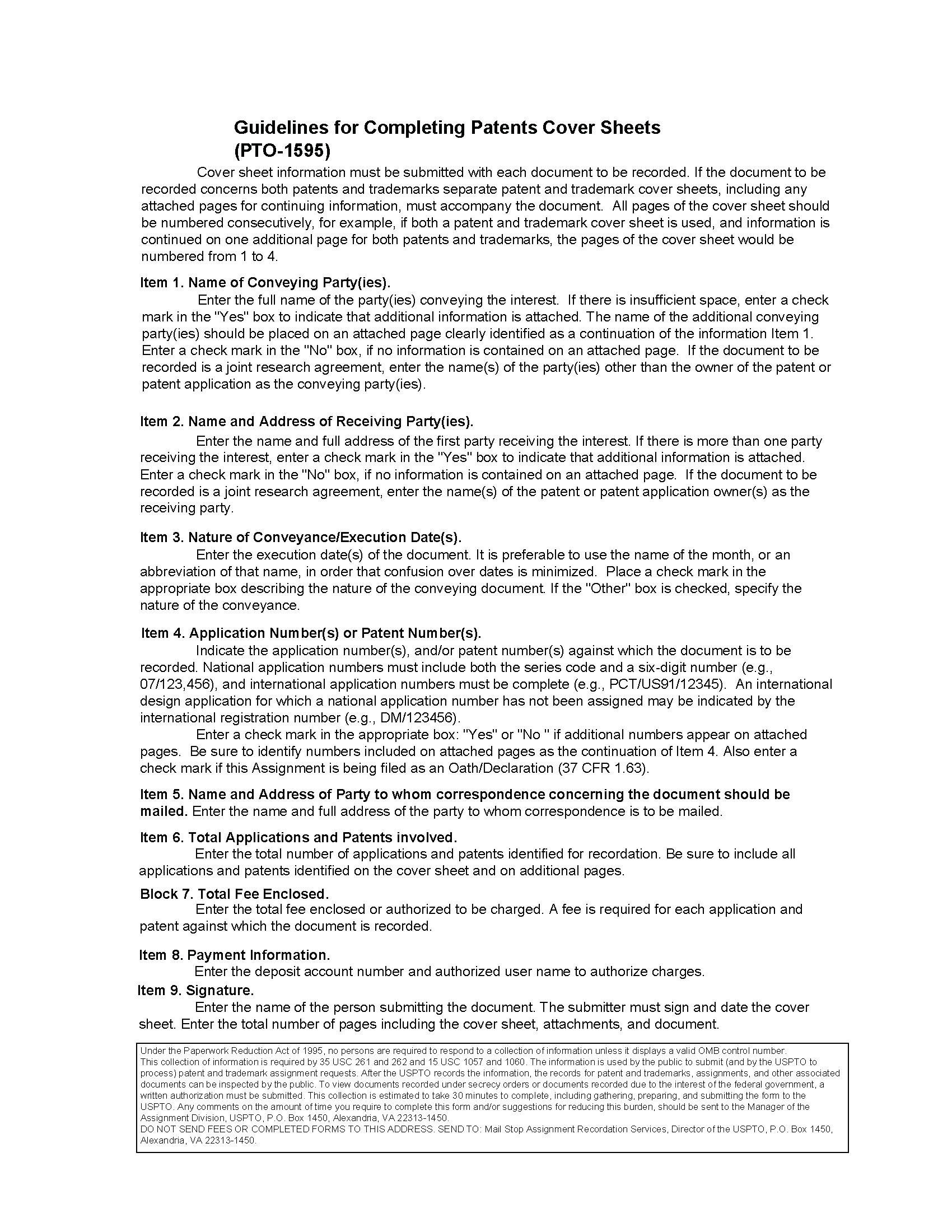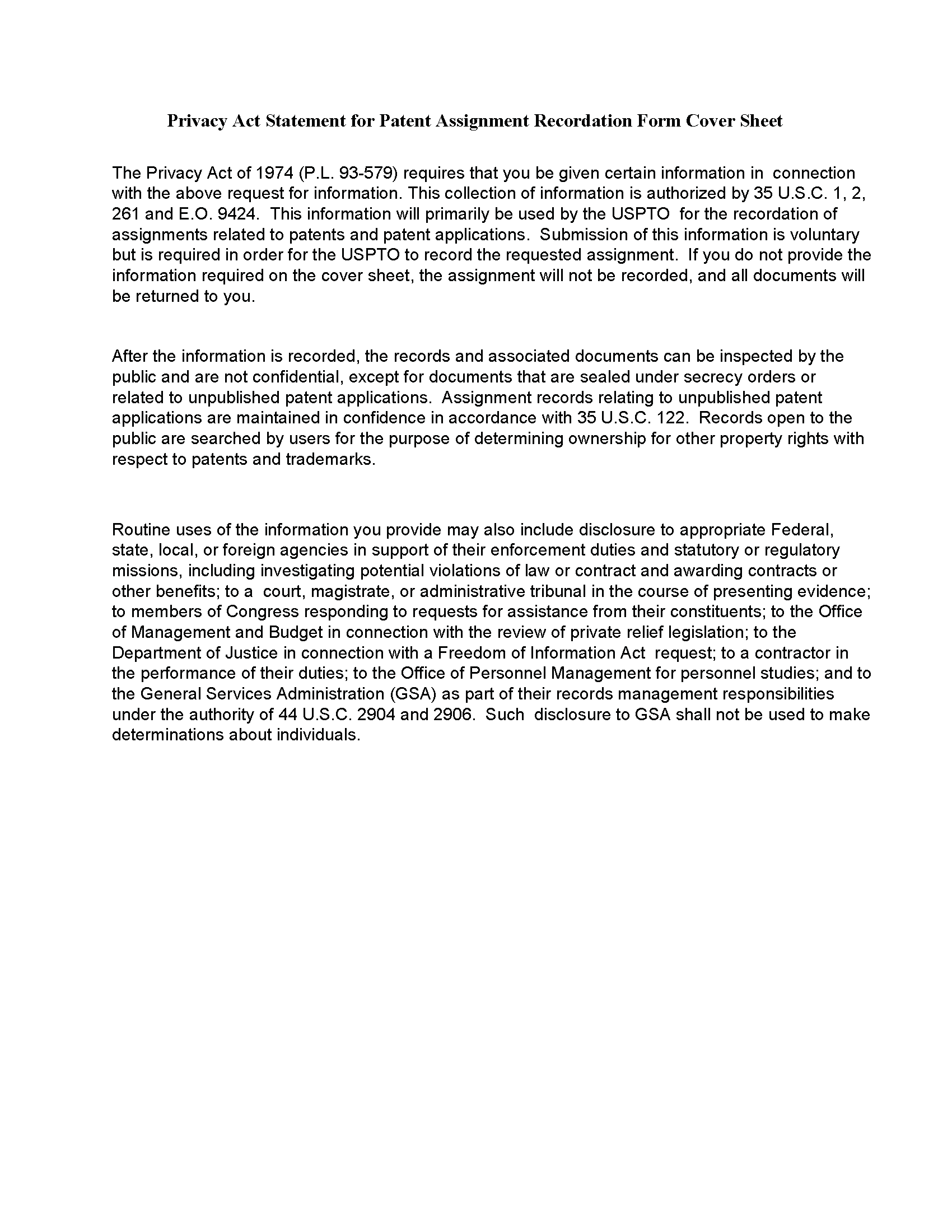- (1) The document does not affect title and is so identified in the cover sheet (see § 3.31(c)(2)); and
- (2) The document and cover sheet are either: Faxed or electronically submitted as prescribed by the Director, or mailed to the Office in compliance with § 3.27.
The recording fee set in 37 CFR 1.21(h) is charged for each patent application and patent identified in the required cover sheet except as provided in 37 CFR 3.41(b). If the request to record a document is submitted electronically, the fee is set forth in 37 CFR 1.21(h)(1), currently at $0. If the request to record a document is not submitted electronically (i.e., is submitted on paper or via facsimile), the applicable fee is set forth in 37 CFR 1.21(h)(2). Customers should check the current fee schedule on the Office website before submitting documents for recordation. See MPEP §§ 302.08 - 302.10 for additional information regarding the acceptable ways to submit documents for recordation.
302.07 Assignment Document Must Be Accompanied by a Cover Sheet [R-10.2019]
37 CFR 3.28 Requests for recording.
Each document submitted to the Office for recording must include a single cover sheet (as specified in § 3.31) referring either to those patent applications and patents, or to those trademark applications and registrations, against which the document is to be recorded. If a document to be recorded includes interests in, or transactions involving, both patents and trademarks, then separate patent and trademark cover sheets, each accompanied by a copy of the document to be recorded, must be submitted. If a document to be recorded is not accompanied by a completed cover sheet, the document and the incomplete cover sheet will be returned pursuant to § 3.51 for proper completion, in which case the document and a completed cover sheet should be resubmitted.
37 CFR 3.31 Cover sheet content.
- (a) Each patent or trademark cover sheet required by § 3.28 must contain:
- (1) The name of the party conveying the interest;
- (2) The name and address of the party receiving the interest;
- (3) A description of the interest conveyed or transaction to be recorded;
- (4) Identification of the interests involved:
- (i) For trademark assignments and trademark name changes: Each trademark registration number and each trademark application number, if known, against which the Office is to record the document. If the trademark application number is not known, a copy of the application or a reproduction of the trademark must be submitted, along with an estimate of the date that the Office received the application; or
- (ii) For any other document affecting title to a trademark or patent application, registration or patent: Each trademark or patent application number or each trademark registration number or patent against which the document is to be recorded, or an indication that the document is filed together with a patent application;
- (i) Place a symbol comprised of letters, numbers, and/or punctuation marks between forward slash marks (e.g. /Thomas O’Malley III/) in the signature block on the electronic submission; or
- (ii) Sign the cover sheet using some other form of electronic signature specified by the Director.
- (1) Indicate that the document relates to a Government interest; and
- (2) Indicate, if applicable, that the document to be recorded is not a document affecting title (see § 3.41(b)).
- (1) Identify the document as a “joint research agreement” (in the space provided for the description of the interest conveyed or transaction to be recorded if using an Office-provided form);
- (2) Indicate the name of the owner of the application or patent (in the space provided for the name and address of the party receiving the interest if using an Office-provided form);
- (3) Indicate the name of each other party to the joint research agreement party (in the space provided for the name of the party conveying the interest if using an Office-provided form); and
- (4) Indicate the date the joint research agreement was executed.
Each assignment document submitted to the Office for recording must be accompanied by a cover sheet as required by 37 CFR 3.28. The cover sheet for patents or patent applications must contain:
- (A) The name of the party conveying the interest;
- (B) The name and address of the party receiving the interest;
- (C) A description of the interest conveyed or transaction to be recorded;
- (D) Each patent application number or patent number against which the document is to be recorded, or an indication that the document is filed together with a patent application;
- (E) The name and address of the party to whom correspondence concerning the request to record the document should be mailed;
- (F) The date the document was executed; and
- (G) The signature of the party submitting the document.
For applications filed on or after September 16, 2012, if the assignment document is also intended to serve as the required oath or declaration, the cover sheet must also contain a conspicuous indication of an intent to utilize the assignment as the required oath or declaration under 37 CFR 1.63. See 37 CFR 3.31(h).
If the document submitted for recordation is a joint research agreement or an excerpt of a joint research agreement, the cover sheet must clearly identify the document as a "joint research agreement" (in the space provided for the description of the interest conveyed if using Form PTO-1595). The date the joint research agreement was executed must also be identified. The cover sheet must also identify the name(s) of the owner(s) of the application or patent (in the space provided for the name and address of the party receiving the interest if using Form PTO-1595). The name(s) of every other party(ies) to the joint research agreement must also be identified (in the space provided for the name of the party conveying the interest if using Form PTO-1595).
Each patent cover sheet should contain the number of patent applications or patents identified in the cover sheet and the total fee.
Examples of the type of descriptions of the interest conveyed or transaction to be recorded that can be identified are:
- (A) assignment;
- (B) security agreement;
- (C) merger;
- (D) change of name;
- (E) license;
- (F) foreclosure;
- (G) lien;
- (H) contract; and
- (I) joint research agreement.
Cover sheets required by 37 CFR 3.28 seeking to record a governmental interest must also (1) indicate that the document relates to a governmental interest and (2) indicate, if applicable, that the document to be recorded is not a document affecting title.
A patent cover sheet may not refer to trademark applications or registrations.
Form PTO-1595, Recordation Form Cover Sheet, may be used as the cover sheet for recording documents relating to patent(s) and/or patent application(s) in the Office.



302.08 Mailing Address for Submitting Assignment Documents [R-08.2012]
37 CFR 3.27 Mailing address for submitting documents to be recorded.
Documents and cover sheets submitted by mail for recordation should be addressed to Mail Stop Assignment Recordation Services, Director of the United States Patent and Trademark Office, P.O. Box 1450, Alexandria, Virginia 22313-1450, unless they are filed together with new applications.
37 CFR 3.27 sets out how documents submitted for recording should be addressed to the Office. In order to ensure prompt and proper processing, documents and their cover sheets should be addressed to the Mail Stop Assignment Recordation Services, Director of the U.S. Patent and Trademark Office, P.O. Box 1450, Alexandria, VA 22313-1450, unless they are filed together with new applications. Requests for recording documents which accompany new applications should be addressed to the Commissioner for Patents, P.O. Box 1450, Alexandria, VA 22313-1450.
302.09 Facsimile Submission of Assignment Documents [R-11.2013]
Assignments and other documents affecting title may be submitted to the Office via facsimile (fax). See the USPTO website or MPEP § 1730 for the facsimile number. This process allows customers to submit their documents directly into the automated Patent and Trademark Assignment System and receive the resulting recordation notice at their fax machine. The customer’s fax machine should be connected to a dedicated line because recordation notices will be returned automatically to the sending fax number through the Patent and Trademark Assignment System. If the Office system is unable to complete transmission of the recordation notice, the notice will be printed and mailed to the sender by U.S. Postal Service first class mail. Recorded documents will not be returned with the “Notice of Recordation.”
Any assignment-related document for patent matters submitted by facsimile must include:
- (A) an identified application or patent number;
- (B) one cover sheet to record a single transaction; and
- (C) payment of the recordation fee by a credit card (use of the Credit Card form, PTO-2038 (see MPEP § 509), is required for the credit card information to be kept separate from the assignment records) or a USPTO Deposit Account.
The following documents cannot be submitted via facsimile:
- (A) Assignments submitted concurrently with newly filed patent applications;
- (B) Documents with two or more cover sheets (e.g., a single document with one cover sheet to record an assignment, and a separate cover sheet to record separately a license relating to the same property); and
- (C) Requests for “at cost” recordation services.
The date of receipt accorded to an assignment document sent to the Office by facsimile transmission is the date the complete transmission is received in the Office. See MPEP § 502.01. The benefits of a certificate of transmission under 37 CFR 1.8 are available.
If a document submitted by fax is determined not to be recordable, the entire document, with its associated cover sheet, and the Office “Notice of Non-Recordation” will be transmitted via fax back to the sender. Once corrections are made, the initial submission, amended, may then be resubmitted by mailing the corrected submission to the address set forth in 37 CFR 3.27. Timely resubmission will provide the sender with the benefit of the initial receipt date as the recordation date in accordance with 37 CFR 3.51.
The Patent and Trademark Assignment System assigns reel and frame numbers and superimposes recordation stampings on the processed and stored electronic images. Accordingly, copies of all recorded documents will have the reel and frame numbers and recordation stampings.
302.10 Electronic Submission of Assignment Documents [R-10.2019]
37 CFR 3.31 Cover sheet content.
- (a)
- *****
- (7) The signature of the party submitting the document. For an assignment document or name change filed electronically, the person who signs the cover sheet must either:
- (i) Place a symbol comprised of letters, numbers, and/or punctuation marks between forward slash marks (e.g. /Thomas O’ Malley III/) in the signature block on the electronic submission; or
- (ii) Sign the cover sheet using some other form of electronic signature specified by the Director.
37 CFR 1.4 Nature of correspondence and signature requirements.
- (d)
- *****
- (2) S-signature. An S-signature is a signature inserted between forward slash marks, but not a handwritten signature as defined by paragraph (d)(1) of this section. An S-signature includes any signature made by electronic or mechanical means, and any other mode of making or applying a signature other than a handwritten signature as provided for in paragraph (d)(1) of this section. Correspondence being filed in the Office in paper, by facsimile transmission as provided in § 1.6(d), or via the Office electronic filing system as an attachment as provided in § 1.6(a)(4), for a patent application, patent, or a reexamination or supplemental examination proceeding may be S-signature signed instead of being personally signed (i.e., with a handwritten signature) as provided for in paragraph (d)(1) of this section. The requirements for an S-signature under this paragraph (d)(2) of this section are as follows.
- (i) The S-signature must consist only of letters, or Arabic numerals, or both, with appropriate spaces and commas, periods, apostrophes, or hyphens for punctuation, and the person signing the correspondence must insert his or her own S-signature with a first single forward slash mark before, and a second single forward slash mark after, the S-signature (e.g., /Dr. James T. Jones, Jr./); and
- (ii) A patent practitioner (§ 1.32(a)(1)), signing pursuant to §§ 1.33(b)(1) or 1.33(b)(2), must supply his/her registration number either as part of the S-signature, or immediately below or adjacent to the S-signature. The number (#) character may be used only as part of the S-signature when appearing before a practitioner’s registration number; otherwise the number character may not be used in an S-signature.
- (iii) The signer’s name must be:
- (A) Presented in printed or typed form preferably immediately below or adjacent the S-signature, and
- (B) Reasonably specific enough so that the identity of the signer can be readily recognized.
- (i) Certification as to the paper presented. The presentation to the Office (whether by signing, filing, submitting, or later advocating) of any paper by a party, whether a practitioner or non-practitioner, constitutes a certification under § 11.18(b) of this subchapter. Violations of § 11.18(b)(2) of this subchapter by a party, whether a practitioner or non-practitioner, may result in the imposition of sanctions under § 11.18(c) of this subchapter. Any practitioner violating § 11.18(b) of this subchapter may also be subject to disciplinary action. See § 11.18(d) of this subchapter.
- (ii) Certification as to the signature. The person inserting a signature under paragraph (d)(2) or (d)(3) of this section in a document submitted to the Office certifies that the inserted signature appearing in the document is his or her own signature. A person submitting a document signed by another under paragraph (d)(2) or (d)(3) of this section is obligated to have a reasonable basis to believe that the person whose signature is present on the document was actually inserted by that person, and should retain evidence of authenticity of the signature. Violations of the certification as to the signature of another or a person’s own signature as set forth in this paragraph may result in the imposition of sanctions under § 11.18(c) and (d) of this chapter.
Assignments and other documents affecting title may be submitted to the Office via the Office’s Electronic Patent Assignment System (EPAS). See the USPTO website at http://epas.uspto.gov for additional information regarding EPAS.
Any assignment related document submitted by EPAS must include:
- (A) an identified application or patent number; and
- (B) one cover sheet to record a single transaction which cover sheet is to be completed on-line.
The fee set in 37 CFR 1.21(h)(1) for recording an electronically submitted document is currently $0. Customers should check the current fee schedule on the Office website before submitting documents for recordation. If a recordation fee is required, see MPEP § 509 for detailed information pertaining to the payment of fees.
For an assignment document filed electronically, the signature of the person who signs the cover sheet must comply with 37 CFR 3.31(a)(7) or 37 CFR 1.4(d)(2).
The date of receipt accorded to an assignment document sent to the Office by EPAS is the date the complete transmission is received in the Office.
If a document submitted by EPAS is determined not to be recordable, the entire document, with its associated cover sheet, and the Office "Notice of Non-Recordation" will be transmitted via fax back to the sender if possible. Once corrections are made, the initial submission, as amended, may then be resubmitted by mailing the corrected submission to the address set forth in 37 CFR 3.27. Timely submission will provide the sender with the benefit of the initial receipt date as the recordation date in accordance with 37 CFR 3.51.
The Patent and Trademark Assignment System assigns reel and frame numbers and superimposes recordation stampings on the processed and stored electronic images. Accordingly, copies of all recorded documents will have the reel and frame numbers and recordation stampings.
- (2) S-signature. An S-signature is a signature inserted between forward slash marks, but not a handwritten signature as defined by paragraph (d)(1) of this section. An S-signature includes any signature made by electronic or mechanical means, and any other mode of making or applying a signature other than a handwritten signature as provided for in paragraph (d)(1) of this section. Correspondence being filed in the Office in paper, by facsimile transmission as provided in § 1.6(d), or via the Office electronic filing system as an attachment as provided in § 1.6(a)(4), for a patent application, patent, or a reexamination or supplemental examination proceeding may be S-signature signed instead of being personally signed (i.e., with a handwritten signature) as provided for in paragraph (d)(1) of this section. The requirements for an S-signature under this paragraph (d)(2) of this section are as follows.
- *****
- (7) The signature of the party submitting the document. For an assignment document or name change filed electronically, the person who signs the cover sheet must either:
- *****